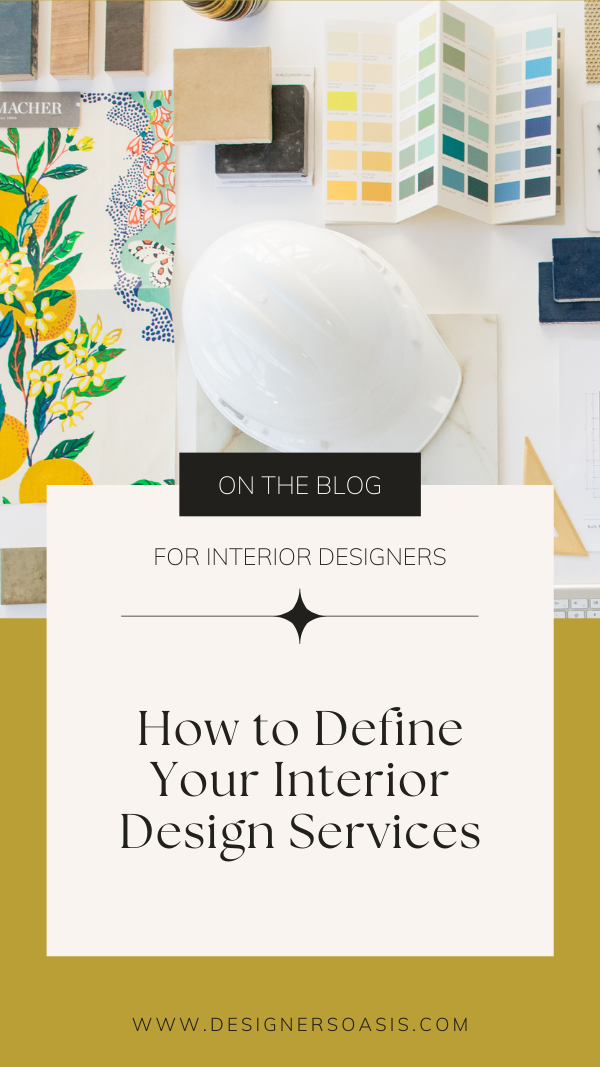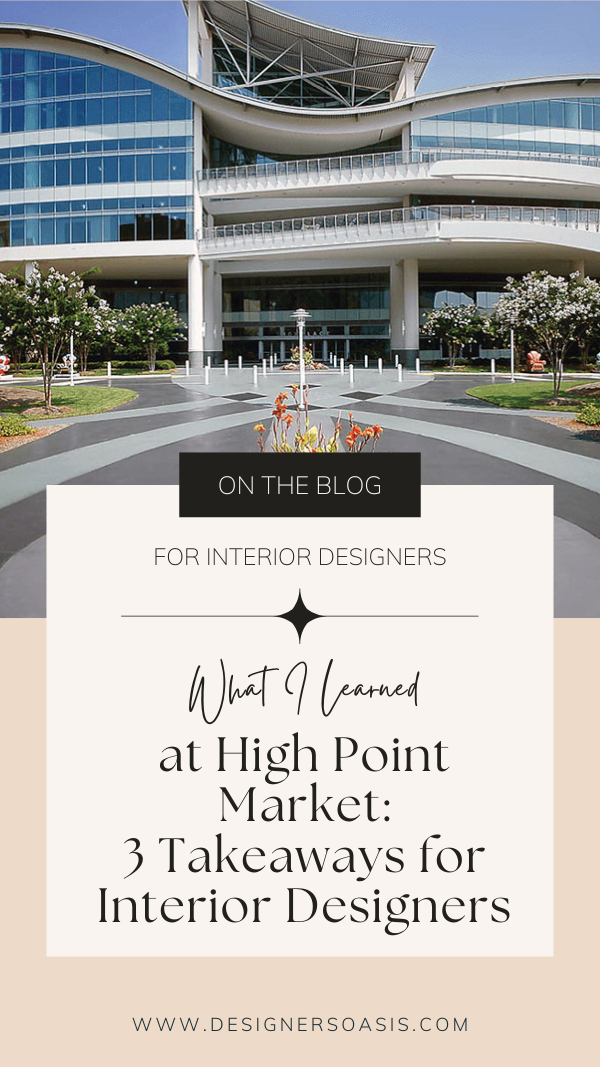How to Define Your Interior Design Services
Welcome back, designer!
Have you ever struggled to explain the differences in your services to potential new clients?
Do you have a clear picture of the benefits of each service and what type of client might be the best fit?
Do you sometimes wonder if you have enough offerings? Or - more likely - offer too many services?
One of the first things I did when I began my own company was outline the service types I wanted to offer. But I quickly learned that I was leaving out super important info that would have helped me talk about my services with more ease and make sure I was suggesting the best option for my client.
A while later, I found myself offering too many services which became confusing for me and worse - my potential new clients.
Today, I understand the value of offering a streamlined ladder of services that are clearly defined and I want to share with you how to get there so that you leave overwhelm at the door for both you and your clients.
DEFINING YOUR SERVICES - WHY IS IT IMPORTANT?
Having clearly outlined design services is paramount to running an efficient and organized business. When you’re just getting started, this is a very important first step, however, it is essential to continue to refine them as you become more established. At KBID, we review our offerings annually and tweak them as needed. For example, a while back, I booked a Designer-for-a-Day Service in a town 2 hours away. Of course, I charged for my travel time too, but after traffic and stopping to eat, I was away for 10 hours and didn’t get to see my girls before bedtime. It was an awful feeling. I decided that I would no longer accept Designer-for-a-Day Clients beyond a 1-hour drive to avoid this happening again.
In this post, we are going to look at common types of designer services alongside the various elements of each service you need to consider and define for yourself. I recommend keeping a detailed outline of each service in your Business Binder that you can refer to when on a call with a potential new client. This internal version is different than a client-facing version that is more focused on the outcomes than the specifics of each service. At the end of the post, you can download a free worksheet to help you define your services for yourself.
THE VALUE OF HAVING TIERED SERVICES
(AKA “LADDER OF SERVICES”)
Offering “tiered services” is the idea that a starter service (like an in-home consultation) could lead to a more comprehensive service (like a Concept Design or Full-Service). These services build on each other. There are a few benefits to doing this:
It gives you the opportunity to understand the client and their needs better
Builds a relationship of trust with your client before committing to a more long-term engagement.
Gives your clients “Value-Driven” options for working with you if Full-Service is out of reach.
COMMON MISTAKES DESIGNERS MAKE WHEN DEFINING SERVICES
Too Many Choices - Like many designers, I have been guilty of offering allllllll the services which only led to confusion and overwhelm for me and my clients. It’s understandable. We see Cutie Designer Girl on Instagram offering Christmas Decorating Services and all of a sudden we think we need to add that option too. Before you know it, your list of services grows and grows and grows while your understanding of them becomes fuzzy. My best advice for you is to keep it simple. Define your Signature Service first. In total, three (max 4) service offerings is plenty.
Customizing Your Services to Pieces - The other big pitfall is making exceptions to your services to the point they no longer resemble the original intention. Let me give you an example. Early on, I had a client dismiss the need for me to provide a Mood Board (color story) and asked if they could skip that part and lower the cost a little bit. I obliged. But as I sat down to start working on the project, realized I really needed that step to help me picture the end result. Two things happened. #1- I cobbled something together anyway (which is time she didn’t pay for) #2 - She didn’t love the original color palette. Had I stuck to my process and let her approve the palette with a moodboard first, I would have done the project in half the time. Define your non-negotiable and stick with them!
““Your hell no’s are as important as your hell yes’s”
— Cleo Wade
COMMON DESIGN SERVICES OFFERINGS
This is a list of common design services. Again, you don’t (shouldn’t) try to incorporate all of them. Offer the ones that make the most sense for you, your personality, your business, and your market. For example, my designer friend Lesley hates Christmas decorating. A mentee of mine lives in a rural area so E-Design makes a lot of sense for her, while another friend would die if she had to spend a whole day with a stranger so “Designer-for-a-Day” would never work for her. Give yourself permission to say no to the things that don’t light you up.
In-home Consultation - This is usually a first meeting that lasts 1-3 hours. You should always charge for this time. Expect to provide value by giving your best ideas and input. This is the ideal service to start with any client.
E-Design - Remote design services done through email and video communication.
Designer-for-a-Day - One time in-home consultation lasting usually from 4-6 hours.
Design Only - In-person services, client does own purchasing and project management
Full-Service - Comprehensive in-person design, purchasing, and project management. Option to do Full-Service without Purchasing but project management. Client would do own purchasing. Pros and Cons to this method.
Color Consultations - In-home consultation focused on paint and color only. Time and deliverables can vary widely.
Finish Selections - Help clients decide on home finishes only such as flooring, tile, wood finishes, paint.
Holiday Decorating - Help clients decorate for holidays. Can be as simple as staging what they already own, or as comprehensive as providing rented elaborate inside and out decorating or cataloging their collection of decor.
Renderings - Provide clients with 3D visuals of finished spaces
Styling - Provide clients with an in-home shoppable styling experience.
Kitchen & Bath Design - Kitchen or bath specific design packages. Specifics can vary widely.
Niche Services
Art Curation
Universal Design
Vegan Design
Children’s Spaces
Custom Furniture Design
Eco Design - Sometimes called Green Design, Healthy Home Design, etc. Useful for people with multiple-chemical sensitivities.
Designing for Special Needs - Designing for Physical, Emotional, Psychological well-being
WHAT DO YOU NEED TO DEFINE?
Name of the Service - Keep it simple and it needs to make sense. Make sure the name clearly reflects the service. “Design Kickstart” for a 2-hour Consultation designed to kickstart a full service project is a good example. You can also simply call it an “In-Home Consultation”.
Description - Describe what the service entails. What are the benefits? What does it achieve?
What is Included? What are the deliverables and what format? Examples include: Moodboard, Shopping List, Drawings, Elevations, In-person meetings (if so - duration, location, and intention should be defined).
What is Excluded? Are drawings provided? Follow-up notes? Project management?
What is the Timeline? 2. hours, 1 Week, 6 Weeks? 4-12 Months?
What is the investment? Is it a flat fee? Is there a range? Is it a custom proposal after a consultation? Is there a minimum for you to accept the job?
Who is the service ideal for? Don’t skip this question! If you’re on the phone with a busy executive what services would be idea for that person? Likely Full-Service. If you offer an E-Design Service, who is ideal for that? You may reveal the service you are offering does not line up with your ideal client and decide to not offer a service for that reason.
What are the terms to book? (i.e. cancellation, minimum # of hours, etc. location limits, etc.) These are your non-negotiables. Here are some examples I use in my business. Full-Service - Minimum 20 hours. Designer-for-a-Day - No further than a 1 hour drive. Design Kickstart - All decision makers need to be present. All services have a strict cancellation policy the must agree to at the time of booking. All services are non-refundable.
How to Book? Online? How to Pay? How to schedule? I use Dubsado and all clients pay, schedule, and sign agreements online before they ever see my smiling face. :)
BOTTOM LINE
Whether you are just starting out or are in growth stages of your business, having clearly defined answers to these questions will keep you focused and therefore profitable.
If you are just starting out - Brainstorm what services make the most sense for you, your lifestyle, and business desires. Create offerings that support all of it.
If you have been in business a while - Look at your current offerings first. What needs to be refined? Do you need to add language to your contracts to minimize risks? Do you need to add an offering that is more bite-sized and can boost your revenue without sacrificing your non-negotiables?
To brainstorm these ideas and more, download the free worksheet below.




